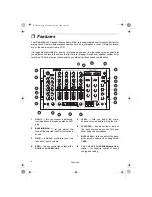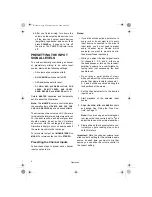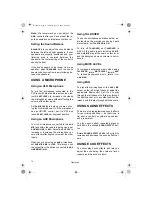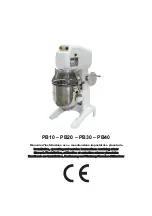
5
Features
9
Assign Controls— let you select the in-
put sources to be mixed.
10
CROSS
FADER
— lets you smoothly
switch between two input sources.
11
SOUND EFFECT
— let you create a spe-
cial sound performance using the six
preprogrammed sound effects.
12
CUE LEVEL
— lets you adjust the head-
phone's volume.
13
CUE ASSIGN
— lets you select the chan-
nel where the desired audio input source
is located so you can monitor and pre-
pare it before mixing it in.
14
BALANCE
— lets you adjust the sound
balance between the left and right
speakers.
15
MASTER
— adjusts the overall volume of
DJ MIG
,
AUX
,
CH1
,
CH2
,
CH3
,
CH4
,
RE-
CEIVE
input, and sound effects.
16
MONO/STEREO
Selector — lets you set
the output to stereo or monaural.
17
POWER
— turns the mixer on and off.
18 Lamp Jack — lets you install a 12V/3W
lamp to light up the mixer controls.
19
ECHO
Controls — let you tailor the
sound to compensate for a location’s
conditions or for personal preference.
20
VU
(Volume Unit) — two meters indi-
cate the total stereo output signal levels.
21 Stereo Line Outputs — let you connect
the mixer's output to your receiver/am-
plifier and tape deck so you can play the
sounds from your input sources through
your speaker system, and record them.
22 Sound Effect Jacks — let you connect
another sound effect device, such as an
echo reverb, and either play the signal
from it or play another input's signal
through it. You can also vary the volume
of the signal.
23 Stereo Line Inputs — let you connect
most line-level audio sources such as a
CD player, tape deck, tuner, camcorder,
or VCR.
24 Auxiliary Microphone Input — lets you
connect a low impedance microphone
with a
1
/
4
-inch plug.
25 Stereo Phono Inputs — for connecting
low-level audio sources, such as a turn-
table with a magnetic cartridge.
26 Mono Line Input — lets you connect a
mono input source, such as a wireless
microphone receiver.
32-3008.fm Page 5 Thursday, April 6, 2000 4:03 PM


































